Your bedroom isn’t just a place to sleep it’s your personal retreat. It’s where you recharge after a long day, relax your mind, and feel at ease. A simple bedroom design can help you achieve this calm, cozy feeling. By keeping things minimal, choosing the right colors, and picking furniture that works, you can turn any bedroom into a peaceful and stylish space.
Whether your room is small or large, following simple design ideas can make it feel open, relaxing, and easy to live in. In this article, we’ll go through practical tips and ideas to help you design a bedroom that feels both beautiful and comfortable.
Why Simple Design Works?
Keeping a bedroom simple isn’t just about style it’s about creating a space that makes you feel calm.
- Less clutter, more calm: A clean, simple room is easier to relax in. Too many decorations or furniture pieces can feel overwhelming.
- Easy to maintain: Fewer items mean less cleaning and a more organized space.
- Timeless style: Simple design with neutral colors and clean furniture never goes out of style and works with different decorating ideas in the future.
- Better sleep environment: A minimal, serene space promotes better rest, as visual distractions and overstimulation are reduced.
In short, simplicity in bedroom design isn’t boring it’s intentional. You focus on what matters most: comfort, style, and peace.
Key Principles for a Simple Bedroom
Here are the main ideas you should follow when designing a simple bedroom:
1. Use Calm, Neutral Colors
Soft, neutral colors like white, beige, light gray, or pastels make a room feel calm and spacious. They also work well with almost any furniture or decoration.
If you want a little color, add soft accents like muted blue, sage green, or blush pink. Keep it subtle so it doesn’t overwhelm the calm feeling. For those who prefer warmth, light terracotta or soft peach tones can make the room feel cozy without being overpowering.
2. Keep Furniture Simple
Choose furniture with clean lines and simple shapes. Avoid ornate or heavy pieces.
Focus on essentials: a bed, a wardrobe, maybe a nightstand. If you need extra functionality, go for furniture with storage — like a bed with drawers or a floating shelf. Lightweight furniture also helps the room feel less crowded.
3. Smart Storage Is Key
Clutter can ruin a simple design. Use smart storage options like wardrobes with closed doors, floating shelves, or under-bed drawers. Only keep what you really need.
Consider using multifunctional furniture, such as a bench with storage at the foot of the bed, or a bedside table with drawers. This keeps the room looking neat while still being functional.
4. Let in Natural Light
Natural light makes a room feel bigger and more inviting. Use sheer curtains or blinds to let sunlight in.
For evenings, use layered lighting — a main light, bedside lamps, and optional accent lights. This makes the room feel cozy without being harsh. Adjustable lighting also allows you to create a relaxing mood before bedtime.
5. Add Natural Materials and Textures
Wood, linen, cotton, jute, or rattan make a room feel warm and inviting. Add textured rugs, throws, or cushions to create depth without clutter.
Mixing textures — smooth wood, soft linens, and woven materials — helps the room feel lived-in and comfortable. Even a small touch, like a wooden lamp base or cotton throw, can add warmth to a minimalist space.
6. Keep Decorations Minimal
A few well-chosen decorations can make a room feel personal without creating clutter. A small plant, a piece of artwork, or a mirror can add character while keeping the space calm.
Decor can also be seasonal — swapping out throws or cushions with soft, neutral patterns can refresh the room without adding clutter.
Simple Bedroom Design Ideas
Here are some practical ways to bring these principles to life:
1. Minimalist Neutral Bedroom
Use whites, beige, or light gray as the main colors. Choose simple furniture and keep decorations minimal. This works especially well in small bedrooms, making them feel more open.
2. Light and Airy Space
Let in as much natural light as possible. Use sheer curtains and mirrors to make the room brighter. This makes the room feel larger and fresher. Adding a small light-colored rug can also enhance brightness and add a cozy feel.
3. Built-In Storage
If space is tight, use built-in wardrobes or wall-to-wall storage. Sliding doors or mirrors on wardrobes save space and make the room feel bigger. Adding vertical shelves for books or decorative items keeps floors clear and organized.
4. Natural Materials
Use wooden furniture, cotton or linen bedding, and woven rugs. These materials make the room feel warm and cozy while staying simple. Layering different textures creates interest without overwhelming the design.
5. Accent Wall
If you want a focal point, consider a subtle accent wall behind the bed. Use a soft pastel, earthy tone, or textured paint. Keep the rest of the room simple so the accent doesn’t overwhelm the space.
6. Floating Furniture
Floating nightstands or shelves free up floor space, making the room feel airier. Keep the layout balanced and furniture proportionate to the room size.
7. Layered Soft Furnishings
Use plain bedding and layer it with a soft throw or a couple of cushions. Add a small rug to make the space cozy. This layering adds visual interest and comfort without cluttering the room.
8. Add Greenery
A few indoor plants can bring life to a minimal bedroom. They are simple, natural, and calming. Plants also improve air quality, making the bedroom healthier and more relaxing.
Tips for Different Room Sizes:
Small Bedrooms
- Use vertical storage and built-in furniture to save floor space.
- Stick to light colors and simple furniture to make the room feel bigger.
- Add mirrors to create a sense of depth.
- Keep decorations minimal but meaningful, like a framed photo or a single plant.
Large Bedrooms
- Use larger furniture like a king-size bed, but keep surrounding furniture minimal.
- Add cozy textures with rugs, throws, and bedding.
- Use soft lighting to maintain warmth and comfort.
- You can also create separate zones, like a reading corner with a comfortable chair, without overcrowding the space.
Adding Personality
- Add subtle accent colors with cushions, throws, or a single wall.
- Include natural or handmade décor like plants, woven baskets, or artwork.
- Keep the overall color palette and furniture style consistent for a calm look.
Common Mistakes to Avoid
- Too bare: A completely empty room can feel cold. Add soft textiles or warm materials to keep it cozy.
- Too much furniture: Avoid mismatched or oversized furniture that breaks the simple aesthetic.
- Dark colors in small rooms: Light colors are best for small spaces.
- Poor lighting: Don’t rely on a single harsh overhead light. Use layered lighting instead.
- Overdecorating: Less is more. Choose a few meaningful decorations instead of many small items.
Step-by-Step Bedroom Planning
- Measure your space – note doors, windows, and ceiling height.
- Pick your color palette – light neutrals for walls and major surfaces, subtle accents if desired.
- Choose essential furniture – bed, wardrobe, nightstand or floating shelves.
- Plan storage – built-ins, under-bed drawers, floating shelves.
- Plan lighting – natural light plus layered artificial lighting.
- Add natural materials – wood, linen, cotton, rugs, cushions.
- Add minimal décor – plant, rug, throw, or artwork.
- Check layout – keep walking space clear, balance furniture placement, make sure everything fits proportionally.
- Test and adjust – live in the space for a few days and tweak if needed.
Below Are Few Simple Bedroom Interior Designs
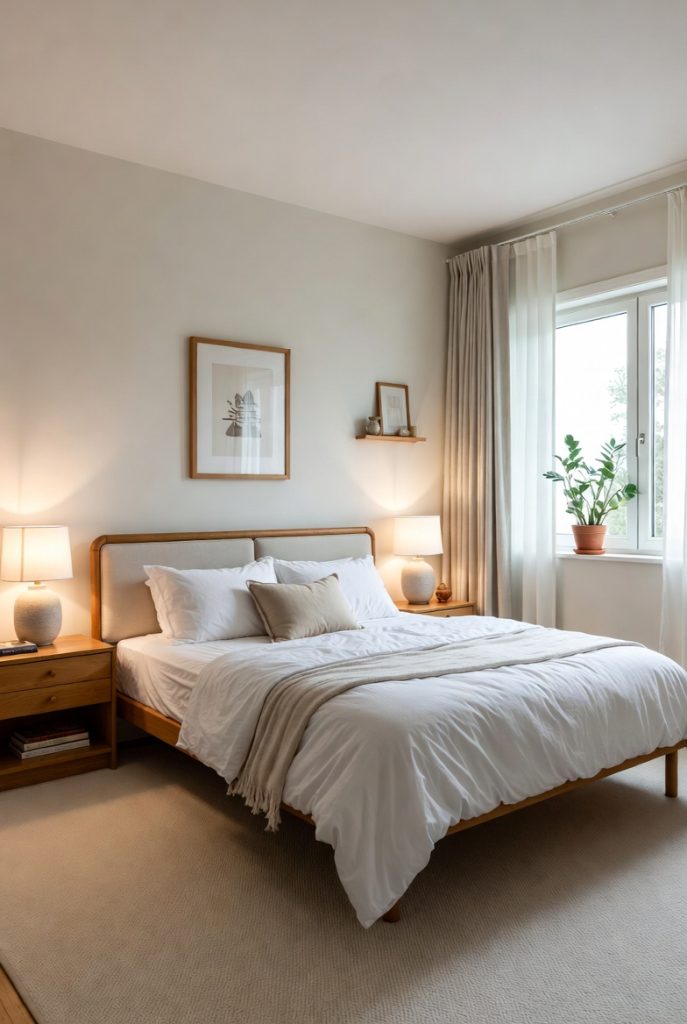
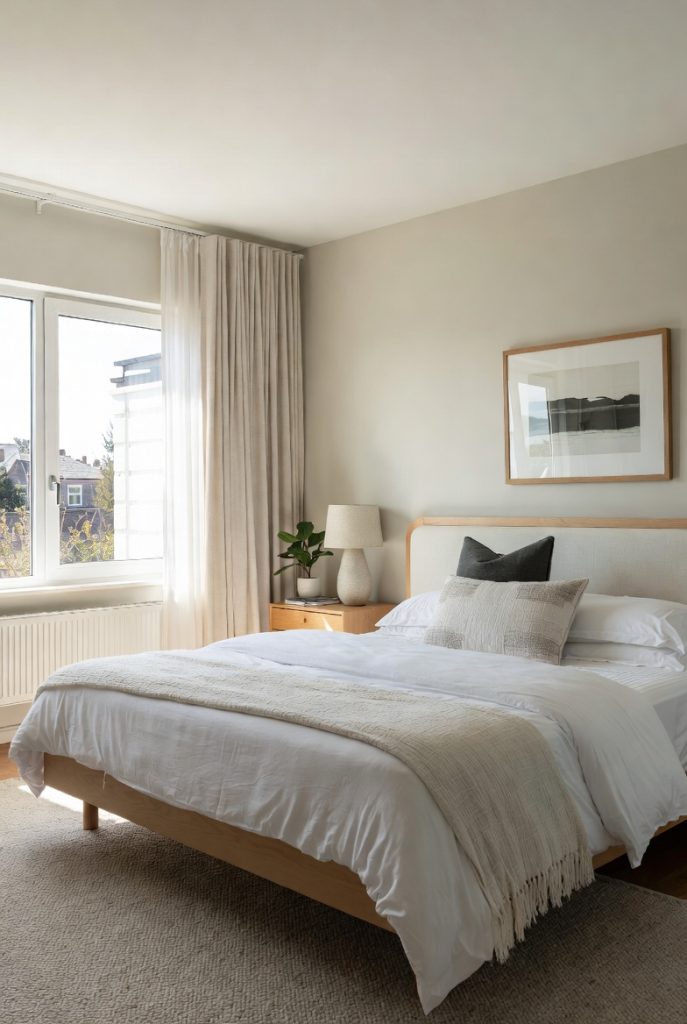

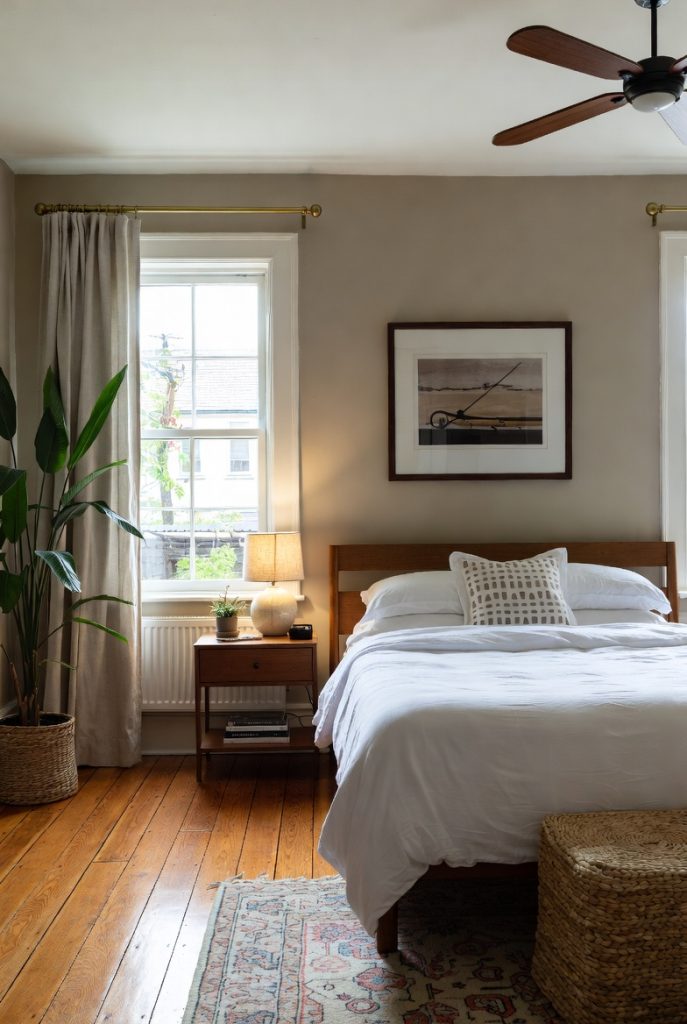


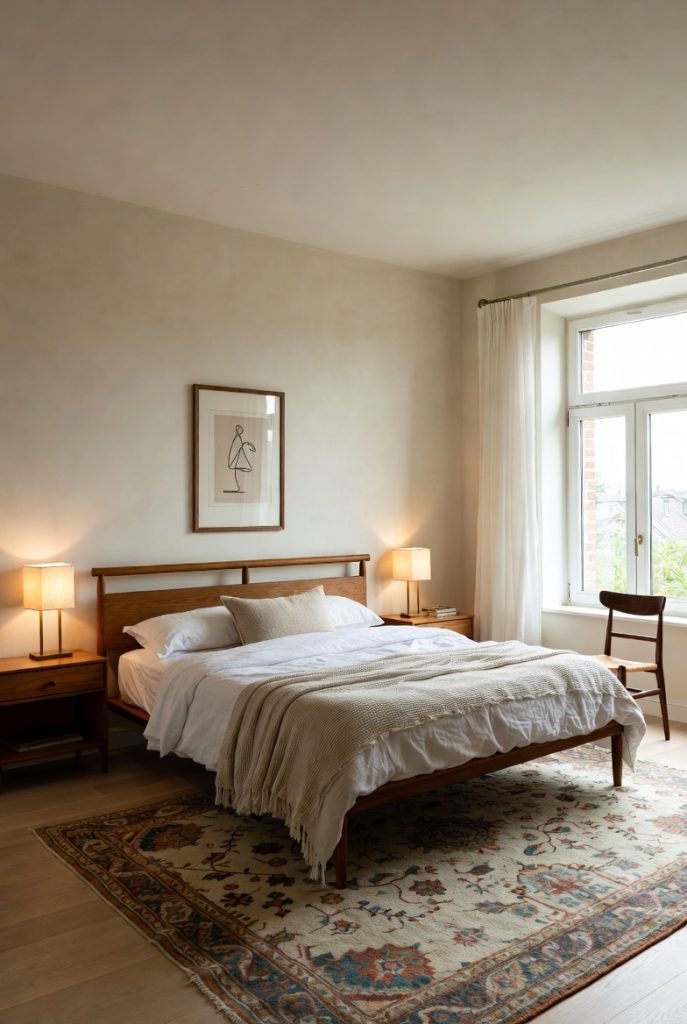
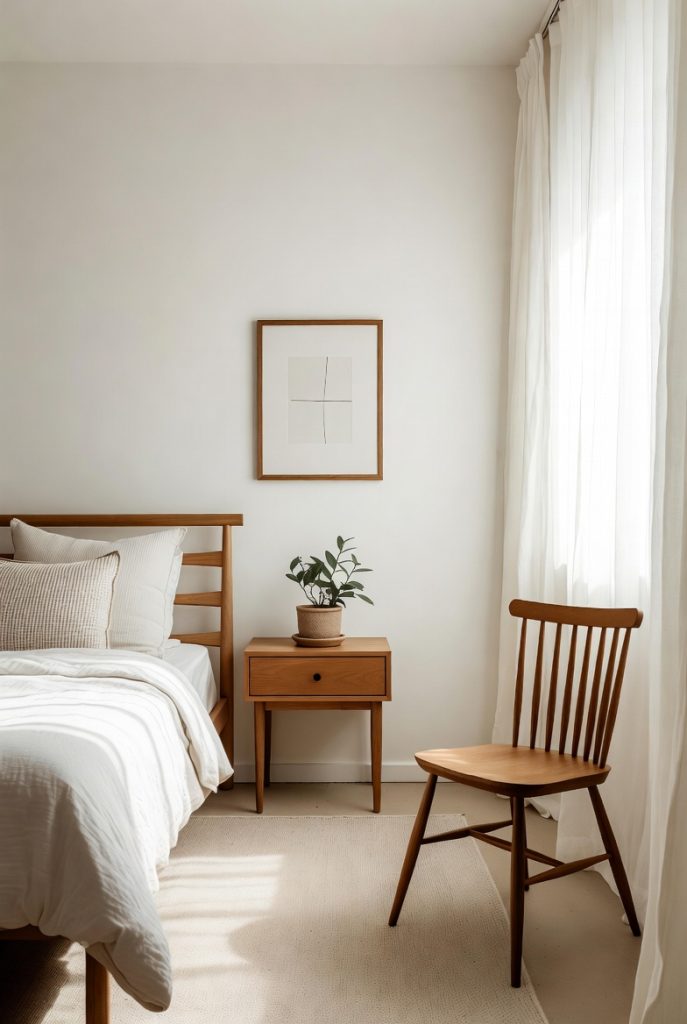
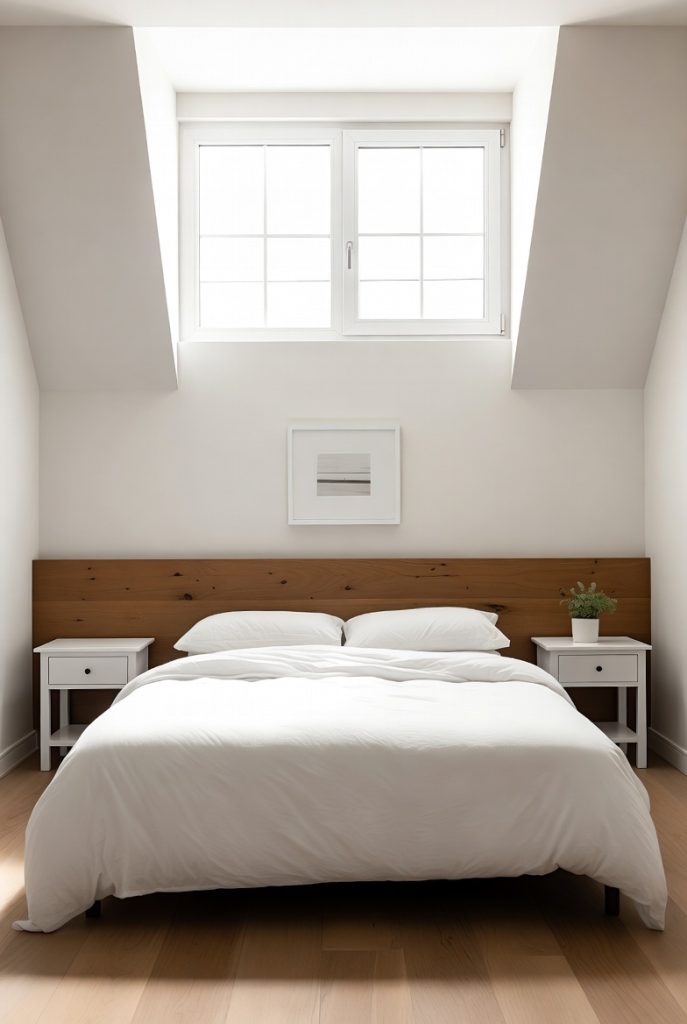

FAQ’s – (Frequently Asked Questions)
Q1. What colors work best for a simple bedroom?
Soft neutrals like white, beige, light gray, or pastels are ideal. You can add soft accent colors like dusty blue, sage green, or muted terracotta.
Q2. How do I make a small bedroom feel bigger?
Use light colors, mirrors, vertical storage, and minimal furniture. Let in as much natural light as possible.
Q3. Should I avoid all décor?
No. A few intentional items like a rug, cushions, or a small plant can make the room cozy without cluttering it.
Q4. Can a simple bedroom still look stylish?
Yes. Clean lines, neutral colors, natural materials, and thoughtful decoration create a stylish and timeless look.
Q5. What furniture works best?
Functional and simple pieces. Beds with storage, floating nightstands, sliding or mirrored wardrobes. Avoid heavy, ornate furniture.
You Might Also Like This:
- Small Boutique Interior Design Ideas (Clean & Stylish)
- Low Budget Simple House Interior Design Ideas
Conclusion:
A simple bedroom can feel peaceful, stylish, and easy to live in. Focus on neutral colors, clean-lined furniture, natural materials, smart storage, and minimal decorations. Layering textures, adding natural light, and incorporating greenery make the space inviting and restful. With these tips, any bedroom — small or large — can become a calm and welcoming retreat.


